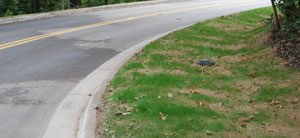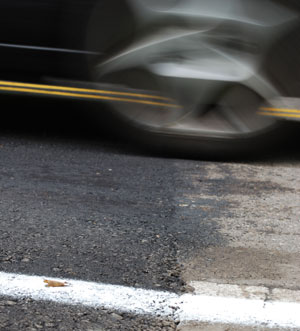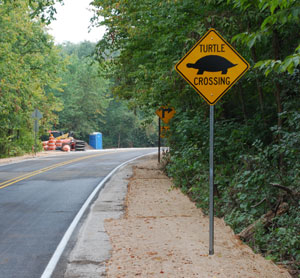Huron River Drive Reconstruction
The detour signage from Bird Hill Road leading to Huron River Drive (HRD) was still in place this morning, but the road itself was open again for business. One driver wasn’t aware that the option to turn right from Bird Hill had been restored, but it didn’t matter because she was planning to turn left anyway.

The ground cover along the shoulders of Huron River Drive is starting to sprout. The goal is that it will help stabilize the shoulders through the winter.
Today’s re-opening of HRD after a temporary closure marked the conclusion of the first phase of road reconstruction plus replacement of sanitary sewers. The remaining work will begin in spring 2009. The most recent of the email updates provided by Liz Rolla, a city planner, since the project was in its conceptual phase, indicates that the final layer of asphalt will be laid towards the end of next year (2009). That layer will erase the seams between the new asphalt already put down and the older sections.

The seams between the old and new asphalt sections will be smoothed over when the final layer of asphalt is laid in late 2009.
The re-construction techniques used on the road reflect the same concern for the natural habitat that led to the consideration of a permanent closure of HRD to motor vehicle traffic. In order to reconstruct the road properly and on a wider footprint to accommodate bicycle lanes, it was feared that the sensitive natural habitats on either side of the road would have to be compromised.
However, at a public meeting held at Forsythe Middle School in April of 2007, Connie Pulcipher of the consulting firm Beckett & Raeder Inc., fielded question after question from speakers objecting to the possible closure of HRD to motor vehicle traffic. [Pulcipher has since joined the city of Ann Arbor planning staff.] Lloyd Carr, then coach of the University of Michigan football team, was cited by one speaker as an example of someone who chose to motor along scenic HRD instead of taking faster, more direct routes.
The potential permanent closure of the road also raised concerns among neighbors about increased traffic along residential streets that would be used as alternate routes, like Warrington Drive and Lowell Road.

Turtles may get some extra consideration from drivers and cyclists on the reconstructed Huron River Drive.
The issue drew enough interest from one of those neighbors, Richard Wickboldt, that he was was prompted to participate on the study committee, and ran for city council in Ward 1 in the August 2007 Democratic primary.
In the end, the city opted to keep the road open to motor vehicular traffic, but sought to minimize the impact on the senstive habitats by making the roadbed as shallow as possible. This was achieved by what the city’s website calls a “burrito” cross section. The burrito shell consists of a geogrid and geofabrics, while the tasty meat filling is crushed rock.




At the request of Dave Askins, I can clarify the purpose of the “turtle crossing” signs. The sign is located near a bend in the road because cars might have inadequate sight lines and stopping distance to avoid wildlife just beyond the bend. It made the most sense to select turtles for the sign, because they do cross the road, and the curb that exists only at the bend in the road is likely to detain them there for longer than it would for any other type of wildlife. A different curb design was considered that would have allowed turtles to climb over it, but this would have required additional area that is currently unavailable at this narrow part of the road.
In other words, we selected the turtle as our “charismatic megafauna” of choice to encourage the public to think about reducing their speed through that sharp curve in the road. While turtles may be constrained by the curb and remain on the road longer than other wildlife (making them the logical focus of the signs), reducing speed through that area will also benefit other wildlife and the human users of the roadside path. The signs weren’t intended to address any particular species of turtle, rare or otherwise. We also didn’t intend for people to interpret the signs to mean that they can speed through that area without worries during winter, when turtles are inactive (although perhaps people could be particularly cautious from May through July, when turtles are most likely to be crossing the road, to find locations to lay eggs!).
I hope that our selection of a somewhat light-hearted speed modification device provokes thought and discussion in the public, about both turtles and other wildlife. As if to reinforce that point, I found an unfortunately dead groundhog on the side of the road there (beyond the curbed and signed area) this morning on my way to work.
Thanks for the opportunity to comment!
You can find Natural Area Preservation on the City’s web site for our calendar of events, if you are interested in other wildlife preservation opportunities in the City.